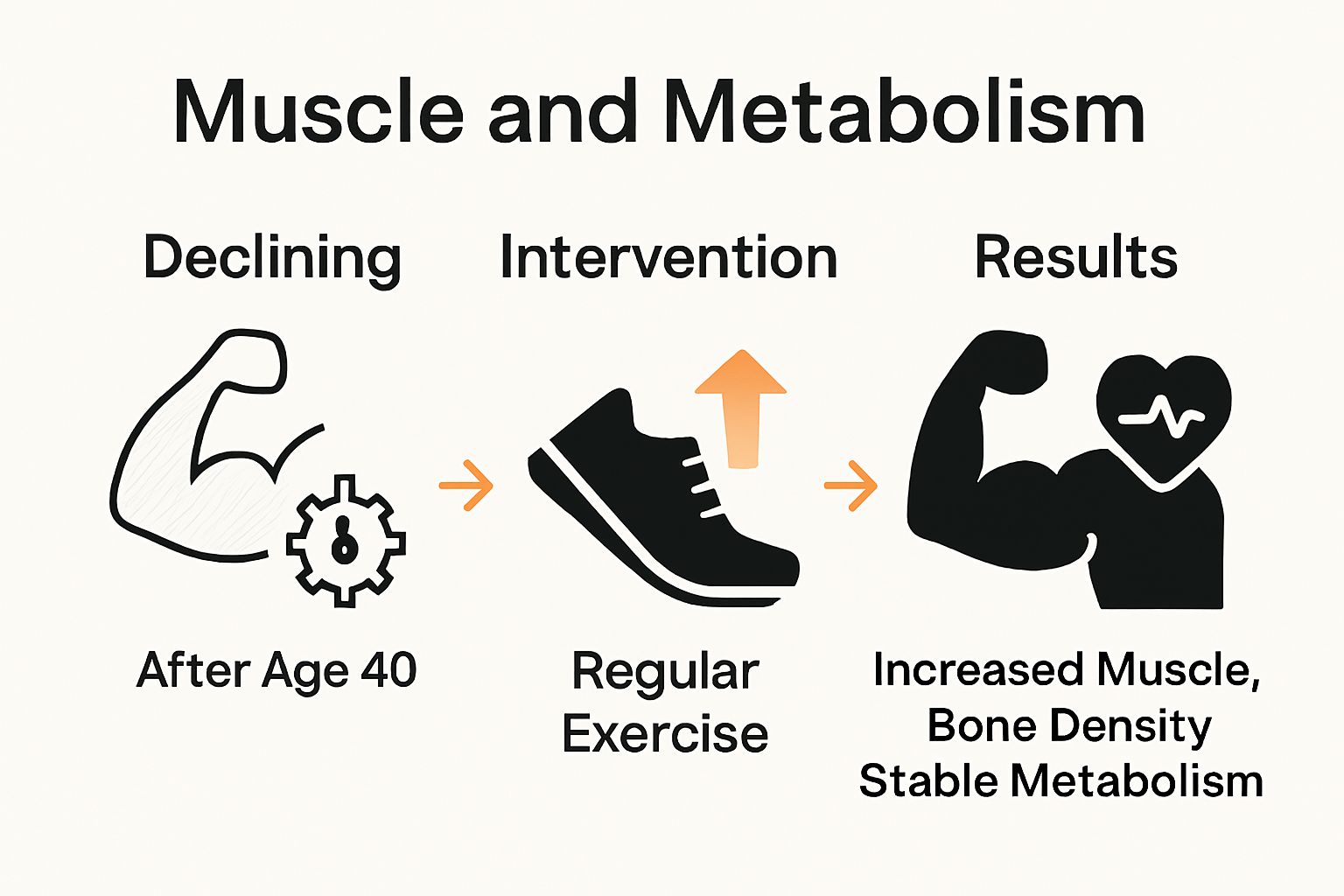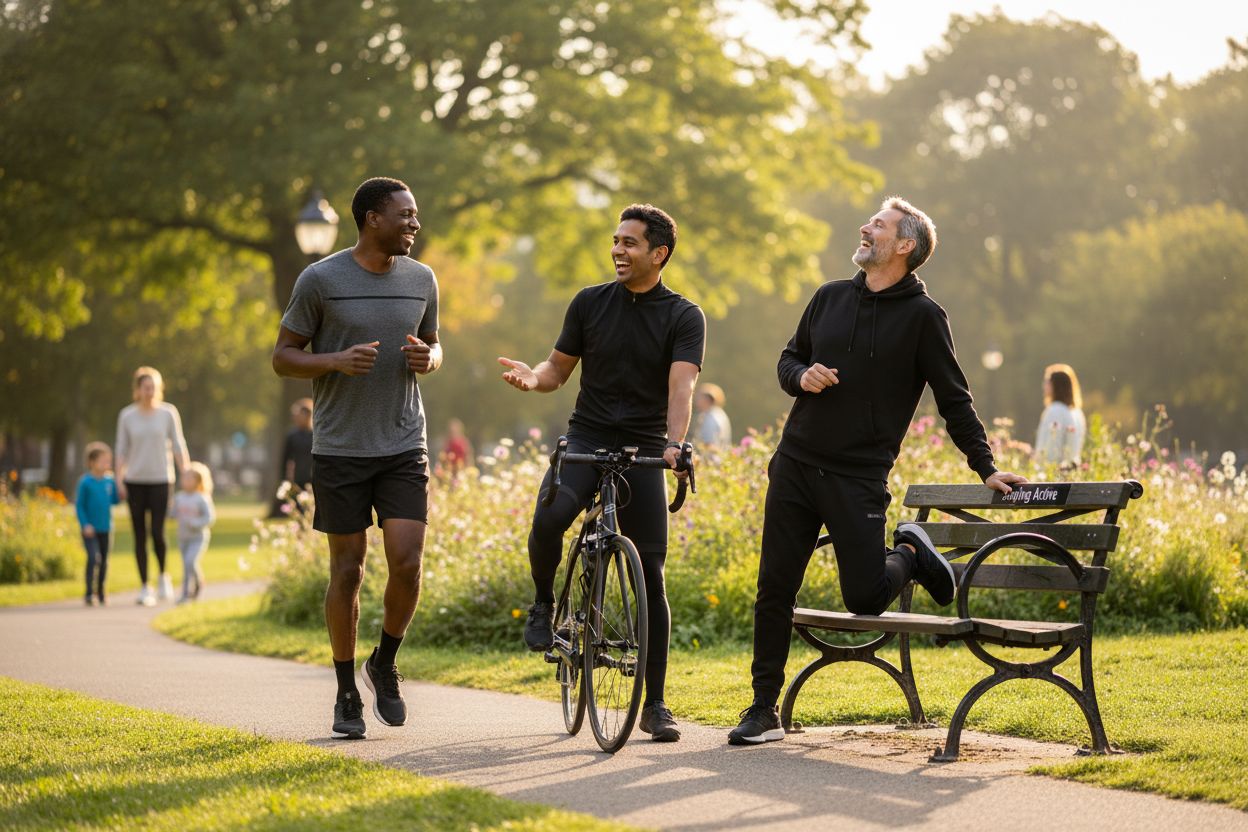Understanding the Benefits of Exercise for Men Over 40

Exercise takes on a whole new meaning for men after 40. Studies reveal that muscle mass can decline by up to 8 percent each decade after middle age and metabolism slows, making fitness more than just a hobby. Most people think slowing down is inevitable, but that old belief falls flat. With the right approach, working out actually reverses these changes and unlocks better health than many men had in their thirties.
Table of Contents
- What Is The Role Of Exercise After 40?
- Why Exercise Matters For Men Over 40
- How Exercise Impacts Physical And Mental Health
- Key Concepts Of Fitness For Mid-life Individuals
- Real-world Benefits Of Staying Active After 40
Quick Summary
| Takeaway | Explanation |
|---|---|
| Regular exercise is essential after 40. | Staying physically active is crucial for health and wellness as men age, helping to counteract physiological declines. |
| Strength training preserves muscle mass. | Engaging in strength training stimulates muscle retention, combats sarcopenia, and enhances overall body composition. |
| Exercise boosts metabolic health. | Regular physical activity improves insulin sensitivity, reduces fat accumulation, and enhances cardiovascular health. |
| Physical activity enhances mental health. | Consistent exercise boosts neuroplasticity, improves mood, and supports cognitive functions, countering age-related mental decline. |
| Prioritize a balanced fitness routine. | A comprehensive fitness regimen should include strength, cardio, and flexibility exercises to optimize overall health. |
What is the Role of Exercise After 40?
Exercise transforms from an optional lifestyle choice to a critical health strategy for men entering their 40s. As the body undergoes significant physiological changes, physical activity becomes a powerful tool for maintaining wellness, preventing age-related decline, and optimizing overall health. Research from the National Institutes of Health confirms that targeted exercise can effectively counteract the natural aging process.
Physiological Adaptation and Muscle Preservation
After 40, men experience a natural decline in muscle mass and metabolic rate, a phenomenon known as sarcopenia. Regular exercise interrupts this biological pattern by stimulating muscle protein synthesis and maintaining lean muscle tissue.
 Strength training becomes particularly crucial, as it directly challenges muscle groups and triggers adaptive responses that combat age-related muscle loss.
Strength training becomes particularly crucial, as it directly challenges muscle groups and triggers adaptive responses that combat age-related muscle loss.
Key physiological benefits include:
- Maintaining muscle mass and strength
- Improving metabolic efficiency
- Supporting bone density preservation
- Enhancing hormonal balance
Metabolic and Cardiovascular Health
Exercise plays a fundamental role in metabolic regulation for men over 40. Physical activity helps manage insulin sensitivity, reduces visceral fat accumulation, and supports cardiovascular health. By engaging in consistent exercise, men can mitigate risks associated with metabolic syndrome, type 2 diabetes, and heart disease. Our guide on managing weight after 40 provides additional insights into metabolic strategies.
Strategic exercise approaches for men in this life stage should focus on balanced, comprehensive fitness routines that incorporate strength training, cardiovascular conditioning, and flexibility work. These multifaceted approaches ensure comprehensive health optimization and support long-term physical resilience.
Why Exercise Matters for Men Over 40
Exercise transcends mere physical activity for men navigating midlife. It becomes a strategic approach to counteracting biological aging, maintaining peak performance, and preserving long-term health potential. Research from Harvard Medical School demonstrates that targeted physical activity can dramatically reshape health trajectories for men over 40.
Hormonal and Metabolic Recalibration
As testosterone levels naturally decline with age, exercise emerges as a powerful intervention for hormonal balance. Strength training and high-intensity interval workouts stimulate testosterone production, counteract muscle degradation, and support metabolic efficiency. This biological recalibration helps men maintain muscle mass, reduce body fat, and sustain energy levels typically associated with younger years.
Key hormonal benefits include:
- Naturally boosting testosterone production
- Improving insulin sensitivity
- Reducing inflammation markers
- Supporting healthy cortisol regulation
Mental Resilience and Cognitive Performance
Physical exercise is not just a body transformation tool but a critical strategy for cognitive health. Regular physical activity stimulates neuroplasticity, enhancing mental clarity, emotional regulation, and stress management. Explore our comprehensive guide on men’s health strategies to understand the holistic impact of exercise on mental wellbeing.
Neurological research indicates that consistent exercise can slow cognitive decline, improve memory function, and reduce the risk of age-related mental health challenges. By engaging in comprehensive fitness routines, men over 40 can maintain neural connectivity, enhance problem-solving skills, and sustain mental sharpness during a transformative life stage.
How Exercise Impacts Physical and Mental Health
Exercise represents a holistic intervention that simultaneously transforms physical capabilities and psychological resilience for men over 40. By engaging in consistent physical activity, individuals can trigger profound systemic changes that extend far beyond muscle development. Research from the National Center for Biotechnology Information reveals the intricate connections between physical movement and comprehensive wellness.
Neurochemical and Physiological Transformation
Physical exercise initiates a complex cascade of neurochemical reactions that recalibrate brain chemistry and metabolic functioning. When men engage in targeted physical activities, their bodies release endorphins, dopamine, and serotonin neurotransmitters that directly influence mood regulation, stress management, and emotional stability. This biochemical response creates a natural mechanism for combating age-related psychological challenges and maintaining mental equilibrium.
Key neurochemical benefits include:
- Reducing cortisol stress hormone levels
- Stimulating neurogenesis in brain regions
- Enhancing neural connectivity
- Improving emotional processing capabilities
Comprehensive Wellness and Resilience
Exercise functions as a multidimensional wellness strategy that addresses interconnected physical and psychological domains. Beyond muscular strength and cardiovascular health, regular physical activity builds psychological resilience, enhances cognitive flexibility, and provides a proactive approach to managing midlife transitions. Discover our blueprint for optimal men’s health to understand the comprehensive approach to wellness.
By integrating structured exercise routines, men can develop a powerful toolkit for navigating complex life challenges, maintaining peak performance, and sustaining long-term physical and mental vitality. The cumulative effect of consistent physical activity creates a robust foundation for holistic health that transcends traditional age-related limitations.
Below is a comparison table summarizing the specific physical, metabolic, hormonal, and mental benefits of exercise after 40 as discussed in the article.
| Benefit Category | How Exercise Helps After 40 | Key Details/Effects |
|---|---|---|
| Muscle Mass Preservation | Slows or reverses muscle loss (sarcopenia) | Retains strength, improves body composition |
| Metabolic Health | Enhances insulin sensitivity and reduces visceral fat | Lowers diabetes and heart disease risk |
| Cardiovascular Health | Supports heart function and circulation | Reduces risk of heart disease |
| Hormonal Balance | Boosts testosterone, improves cortisol regulation | Counters age-related hormonal decline |
| Cognitive & Mental Health | Stimulates neuroplasticity and emotional regulation | Improves mood, mental clarity, and reduces decline |
| Bone Density | Supports bone health through weight-bearing activities | Reduces osteoporosis risk |
Key Concepts of Fitness for Mid-life Individuals
Fitness for men over 40 requires a strategic, nuanced approach that recognizes the body’s evolving physiological landscape.
This table presents the essential components of a balanced fitness approach for mid-life men, highlighting the main elements and their primary focus according to the information in the article.
| Fitness Component | Focus Area | Primary Benefits in Mid-Life |
|---|---|---|
| Strength Training | Muscle mass & strength | Counters sarcopenia, boosts metabolism |
| Cardiovascular Work | Heart & metabolic health | Lowers disease risk, increases stamina |
| Flexibility/Mobility | Joint range of motion, injury prevention | Supports movement quality, reduces pain |
| Recovery/Rest | Repair & adaptation | Prevents overtraining, supports sustainability |
| Functional Fitness | Real-world strength & coordination | Improves daily performance, prevents injury |
Functional Fitness and Biomechanical Intelligence
Functional fitness transcends traditional muscle-building approaches by focusing on movement quality, joint mobility, and practical strength applications. For men navigating midlife, this means designing exercise routines that enhance daily performance, prevent injuries, and maintain comprehensive physical capabilities. Exercises that mimic real-world movements become paramount, targeting multiple muscle groups simultaneously and improving overall biomechanical efficiency.
Critical functional fitness principles include:
- Prioritizing compound movements over isolated exercises
- Developing core stability and balance
- Enhancing flexibility and range of motion
- Creating resilient, adaptable muscle groups
Holistic Recovery and Sustainable Performance
Recovery becomes an equally important component of fitness as men progress through their 40s. Understanding bodily signals, implementing strategic rest periods, and recognizing individual limits prevents overtraining and supports long-term physical sustainability. Learn more about relationship balance during life transitions to understand how comprehensive wellness extends beyond physical training.
Successful mid-life fitness requires a paradigm shift from competitive, high-intensity approaches to intelligent, measured progressions that respect individual physiological boundaries. By embracing a holistic view of fitness that integrates strength, flexibility, recovery, and mental resilience, men can create sustainable pathways to peak physical performance and vitality.
Real-world Benefits of Staying Active After 40
Staying physically active after 40 transforms from a lifestyle choice to a critical health strategy with profound long-term implications. Physical activity becomes a powerful mechanism for preserving physical capabilities, preventing age-related decline, and maintaining comprehensive wellness. Research from the Mayo Clinic underscores the transformative potential of consistent physical engagement.
Metabolic and Physiological Preservation
Regular exercise acts as a biological reset button for men navigating midlife metabolic shifts. By maintaining consistent physical activity, individuals can counteract natural declines in muscle mass, metabolic rate, and hormonal balance. This proactive approach helps prevent insulin resistance, reduce visceral fat accumulation, and sustain cardiovascular efficiency. The body responds to structured exercise by preserving muscle tissue, optimizing hormone production, and enhancing overall metabolic resilience.
Key metabolic preservation benefits include:
- Maintaining muscle mass and strength
- Improving insulin sensitivity
- Reducing risk of metabolic syndrome
- Supporting consistent energy levels
Long-term Health and Independence
Consistent physical activity directly correlates with enhanced quality of life and sustained personal independence. Beyond immediate physical benefits, exercise becomes a preventative healthcare strategy that mitigates risks of chronic diseases, supports cognitive function, and maintains mobility. Explore our comprehensive fitness guide for men over 40 to understand advanced strategies for maintaining peak physical condition.
By integrating regular exercise, men can create a robust physiological foundation that supports not just survival, but thriving through midlife and beyond. The cumulative effect of sustained physical activity translates into improved functional capacity, reduced healthcare expenses, and a more vibrant, engaged life experience.

Ready to Reimagine Fitness and Wellbeing After 40?
You know that maintaining muscle, metabolic health, and mental sharpness becomes essential as you move through your 40s. The article highlighted the struggles of losing muscle, declining energy, and shifting hormones. Achieving real change requires more than guesswork. It means working with routines and approaches proven to deliver results for men in midlife. For real solutions, explore our expert-curated Fitness After 40 for Men guides. These resources break down effective workout routines, strength strategies, and exercise plans specifically designed for your evolving needs.
Take your next step with confidence. The team at SecondActMan brings you motivation, practical tips, and a supportive community focused on health transformations after 40. Want to address hormone balance and energy too? Learn how Hormone Optimization for Men Over 40 can work with your fitness journey. Visit now and let us help you turn knowledge into action. Your strongest years can still be ahead. Start today while your motivation is high.
Frequently Asked Questions
What types of exercise are best for men over 40?
Engage in a balanced routine that includes strength training, cardiovascular workouts, and flexibility exercises. Aim for at least 150 minutes of moderate aerobic activity each week, alongside two days of muscle-strengthening activities.
How can exercise help manage hormonal changes after 40?
Exercise can naturally boost testosterone production and improve insulin sensitivity, helping to counteract hormonal declines. Incorporate strength training and high-intensity interval workouts into your weekly routine to support hormonal balance.
How often should men over 40 exercise to maintain muscle mass?
Aim to perform strength training exercises at least two to three times a week to effectively maintain muscle mass and strength. Focus on compound movements that engage multiple muscle groups to maximize efficiency in your workouts.
What are the mental health benefits of exercising after 40?
Regular physical activity can improve cognitive function and emotional regulation, helping to combat age-related mental health challenges. Strive for at least 30 minutes of exercise most days to enhance your mental clarity and emotional stability.
How can I create a sustainable workout plan post-40?
Start with a personalized fitness routine that balances intensity and recovery, listening to your body’s signals. Consider incorporating a variety of activities such as walking, strength training, and yoga to keep your workouts interesting and maintain long-term adherence.







